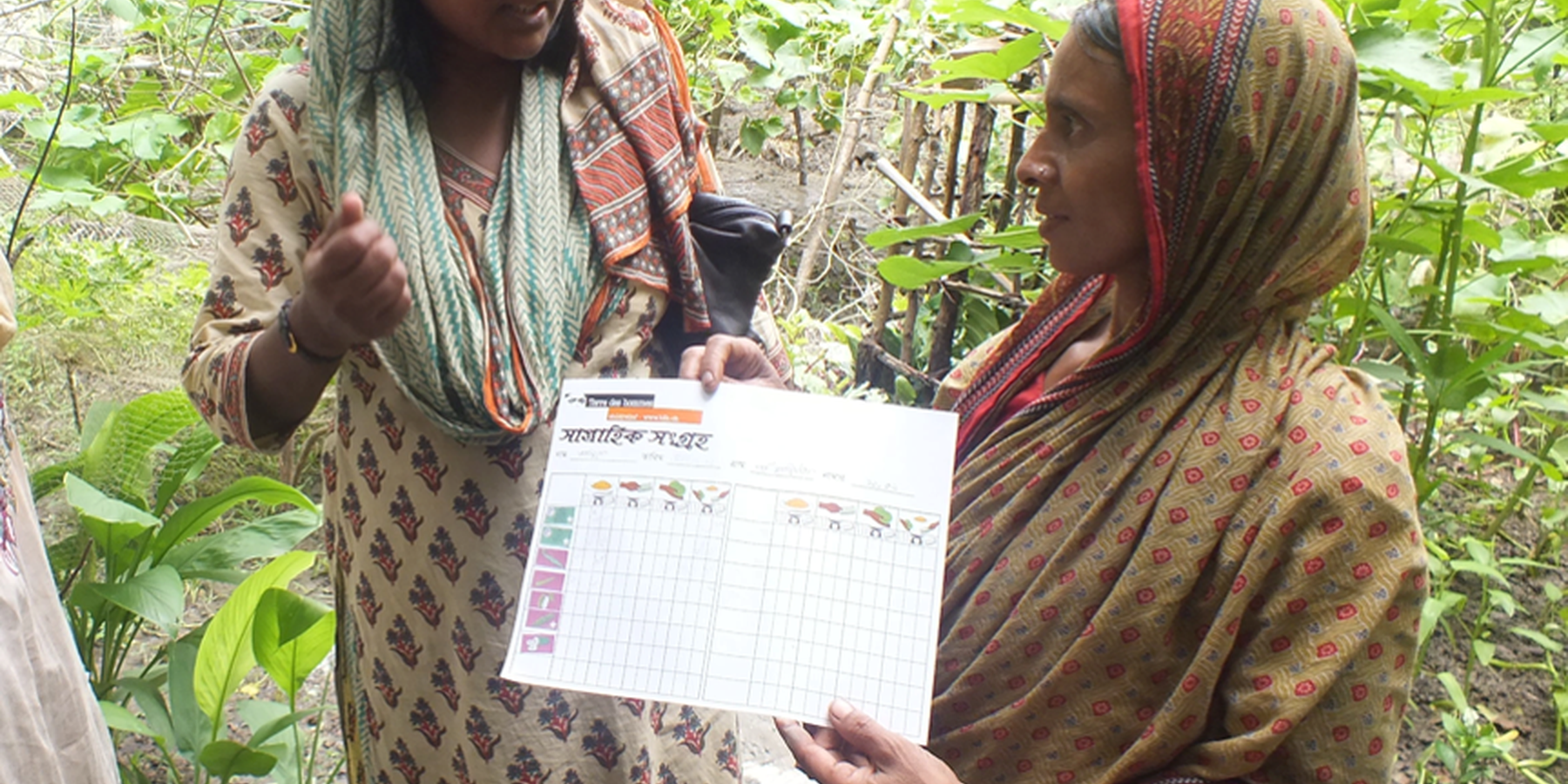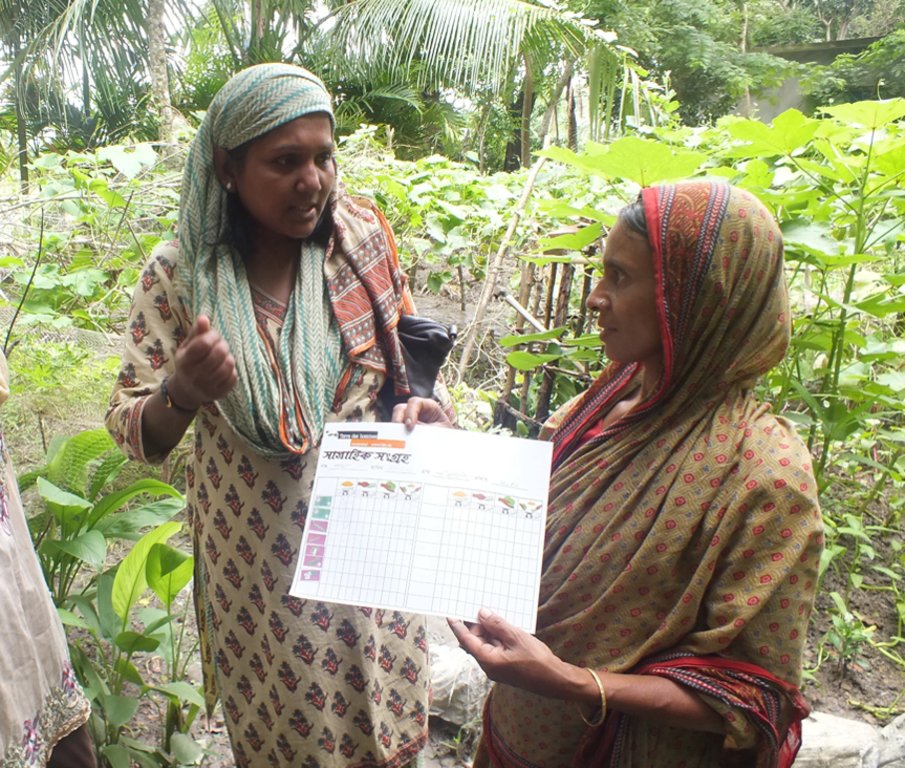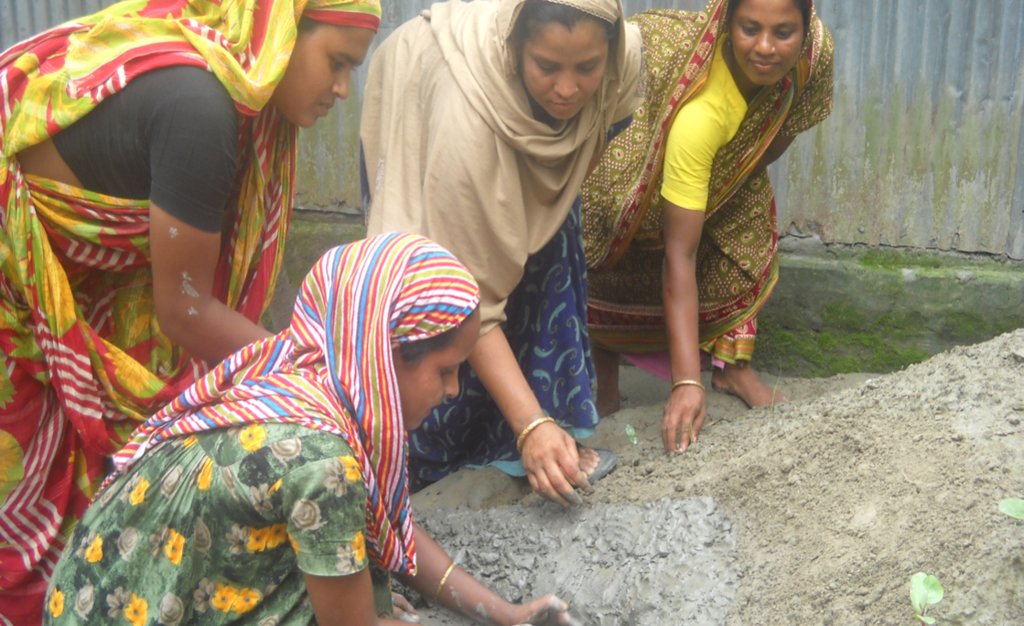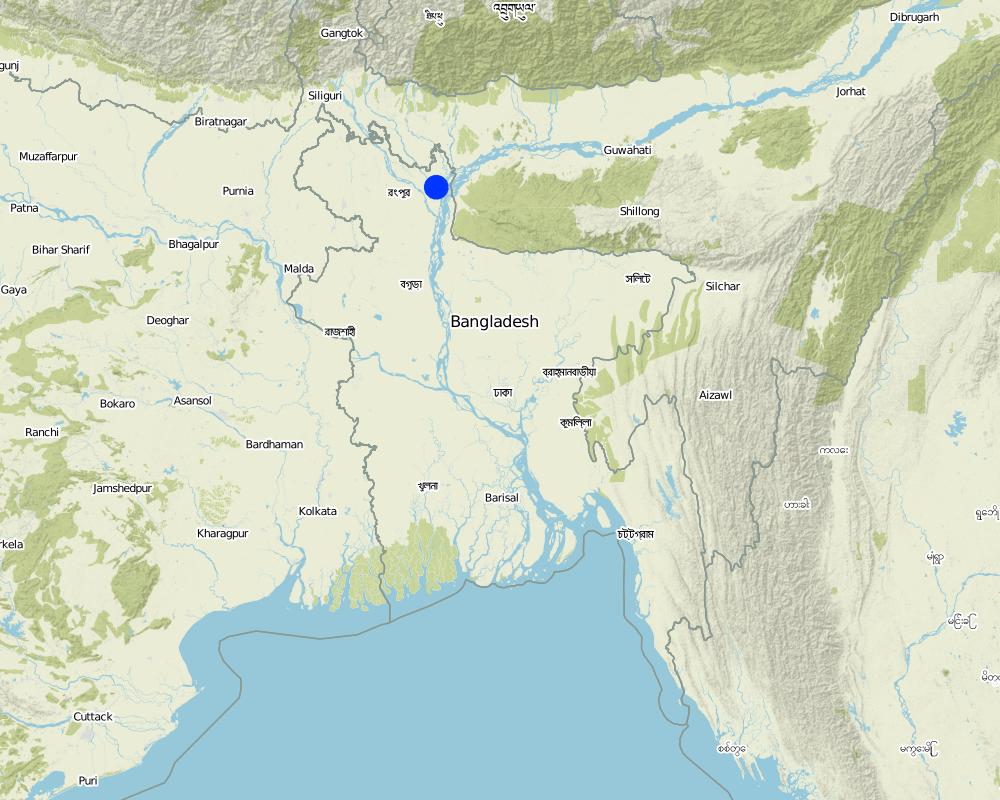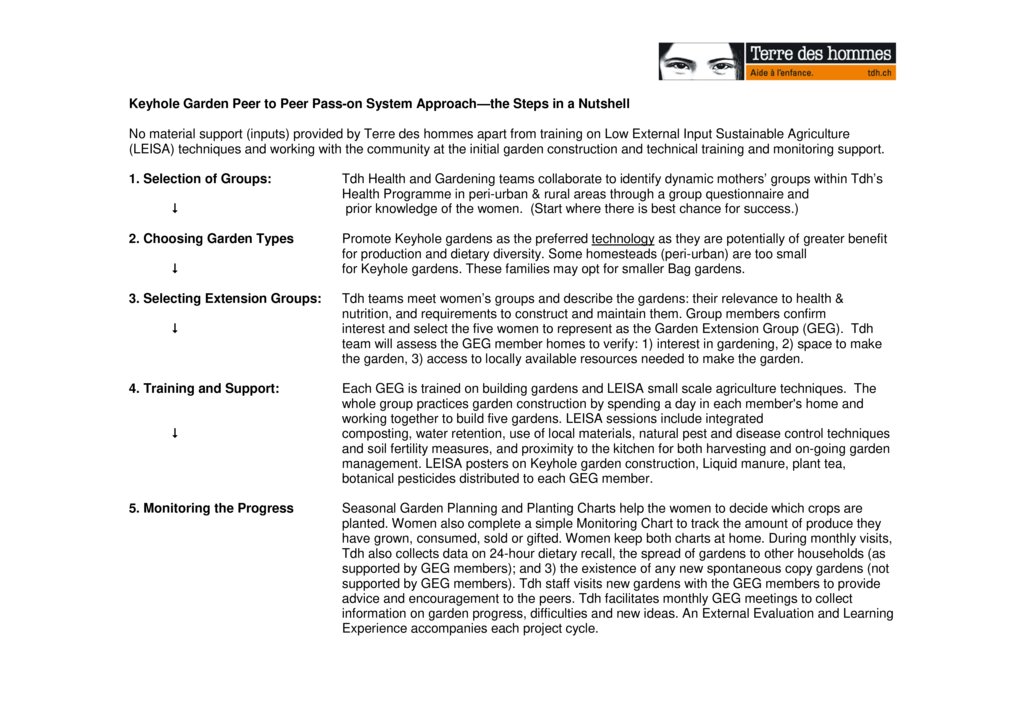Peer to Peer Pass-on Approach with Women [Bangladesh]
- Criação:
- Atualização:
- Compilador/a: John Brogan
- Editor: Shahid Kamal
- Revisores: Alexandra Gavilano, Boris Orlowsky
approaches_784 - Bangladesh
Veja as seções
Expandir tudo Recolher tudo1. Informação geral
1.2 Detalhes do contato das pessoas capacitadas e instituições envolvidas na avaliação e documentação da abordagem
Pessoa(s) capacitada(s)
Especialista em GST:
Brogan John
john.brogan@tdh.ch
Terre des hommes
15 Avenue Montchoisi 1006 Lausanne
Suíça
WASH/DRR Advisor:
Especialista em GST:
Taylor Sheila
Sheila.Taylor@sendacow.org
Send a Cow UK
Nome do projeto que facilitou a documentação/avaliação da Abordagem (se relevante)
Book project: where people and their land are safer - A Compendium of Good Practices in Disaster Risk Reduction (DRR) (where people and their land are safer)Nome da(s) instituição(ões) que facilitou(ram) a documentação/avaliação da Abordagem (se relevante)
Terre des Hommes (Terre des Hommes) - Suíça1.3 Condições em relação ao uso da informação documentada através de WOCAT
Quando os dados foram compilados (no campo)?
14/08/2013
O/a compilador/a e a(s) pessoa(s) capacitada(s) aceitam as condições relativas ao uso de dados documentados através da WOCAT:
Sim
1.4 Referência ao(s) questionário(s) sobre tecnologias da GST
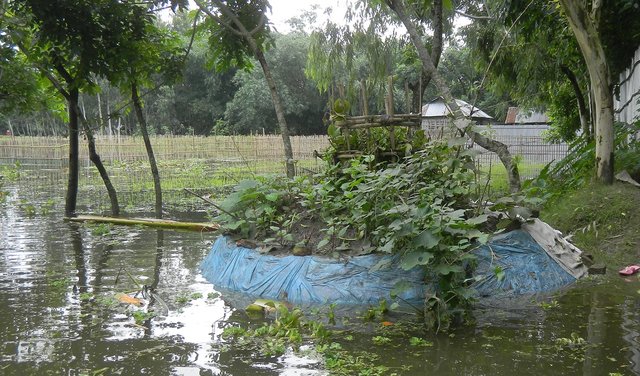
Keyhole Garden [Bangladesh]
The Keyhole Garden model of homestead vegetable cultivation enhances the resilience of families living in areas with climate-related hazards, such as flooding and drought. Keyhole gardens have been shown to increase vegetable production in all seasons, thereby improving household food autonomy and dietary diversity.
- Compilador/a: John Brogan
2. Descrição da abordagem de GST
2.1 Descrição curta da abordagem
Terre des hommes and Greendots introduced the Peer to Peer pass-on system to enable women's groups in Bangladesh to spread the Keyhole Garden technique within their communities with the aim of enabling year-round homestead vegetable production despite the risk of flooding and tidal surge.
2.2 Descrição detalhada da abordagem
Descrição detalhada da abordagem:
Keyhole Gardens, a type of small, productive homestead vegetable garden based on Low External Input Sustainable Agriculture (LEISA) techniques, have been used in various African countries for over 15 years and shown to increase the availability of food and dietary diversity (FAO). They were developed by gardeners and small-scale farmers (with the support of Send a Cow UK) to suit different situations, such as the cold, dry winters of Lesotho, the small backyards of Rwanda, and the humid heat of central Uganda. To improve year-round homestead nutritional self-sufficiency for vulnerable families in South Asia (where rates of acute malnutrition in young children regularly cross emergency thresholds), Keyhole gardens were adapted by Terre des hommes (Tdh) and Greendots to the conditions of river basin and coastal areas of Bangladesh (and eventually to India's Sundarbuns) . As a component to Tdh's maternal neonatal and child health (MNCH) programme, the technology is intended to support year-round homestead gardening despite weather extremes (flooding, tidal surge, cyclones).
To promote spontaneous replication of the Keyhole gardening in the local communities, the programme initiated a Peer to Peer Pass-on system within 40 mothers' groups (having a total membership of nearly 800 women). Each mothers' group selected five representatives (200 women) to form a Garden Extension Group (GEG) and participate in the first round of training with the understanding that they would share knowledge with other women in the MNCH programme and the surrounding community. The project team trained each GEG on building gardens and LEISA small scale agriculture techniques (including integrated composting, water retention, use of local materials, natural pest and disease control techniques and soil fertility measures, proximity to the kitchen for optimal management and harvesting). GEG group members practiced garden construction by working together to build gardens at the homes of all five members. All 200 initial gardens were monitored by Tdh extension workers on a weekly basis. Tdh verified output, use and the capacity of gardens to withstand monsoon conditions, and the extent of the of the Peer to Peer Pass-on experience.
See the Chart in Section 3.3 for more information.
2.3 Fotos da abordagem
2.4 Vídeos da abordagem
Comentários, breve descrição:
https://www.youtube.com/watch?v=WmDgGa0XIO8
BBC Media Action Bangladesh produced a segment on its "Amrai Pari" programme for the Bangladeshi public (in Bangla language) describing women's use and promotion of the Keyhole Garden technique in coastal communities on the Bay of Bengal.
Data:
09/11/2014
Localização:
Barguna District, Barisal Division, Bangladesh
Nome do cinegrafista:
BBC Media Action
2.5 País/região/locais onde a abordagem foi aplicada
País:
Bangladesh
Região/Estado/Província:
Kurigram District / Rajshahi Division and Barguna District / Barisal Division
Especificação adicional de localização:
Kurigram municipality (Kurigram District), Patharghata Union (Barguna District)
Map
×2.6 Datas de início e término da abordagem
Indique o ano de início:
2012
2.7 Tipo de abordagem
- Baseado em projeto/programa
2.8 Principais metas/objetivos da abordagem
The main aims of the approach are to involve women by building their capacity and peer network to replicate the Keyhole gardening approach within their communities.
The main objective of the approach is that that families, led by women 1) garden year-round with LEISA techniques, 2) increase the quantity and diversity of their homestead vegetable production and 3) verify that the DRR garden design reduces the consequences of flooding and tidal surge.
2.9 Condição que propiciam ou inibem a implementação de tecnologia/tecnologias aplicada(s) segundo a abordagem
Normas e valores sociais/culturais/religiosos
- Propício
Acceptance of women's groups, existing mothers' groups within Health programme
Conhecimento sobre GST, acesso a suporte técnico
- Propício
The Approach calls for capacity building on LEISA techniques (knowledge on SLM) via the Peer to Peer Pass-on system to spread the DRR-designed gardens.
3. Participação e papel das partes interessadas envolvidas
3.1 Partes interessadas envolvidas na abordagem e seus papéis
- Usuários de terra/comunidades locais
Homestead land users (women)
Building the gardens: learning and eventually training their peers
- Organizações comunitárias
Mothers' groups
Garden extension groups to share the Keyhole Garden techniques within the scope of their maternal neonatal & child health & activities
- Especialistas em GST/ consultor agrícola
Greendots (www.greendots.ch)
Technical support with design of the approach: Daniel Varadi and Sheila Taylor.
- Organização internacional
Terre des hommes (international NGO)
Project implementing Agency, direct connection with women's groups within its MNCH Programme via Dr. Sultana Al-Amin (Gardening Specialist).
Caso várias partes interessadas foram envolvidas, indique a agência líder:
Terre des hommes
3.2 Envolvimento do usuários de terra/comunidades locais nas diferentes fases da abordagem
| Envolvimento do usuários de terra/comunidades locais | Especifique quem estava envolvido e descreva as atividades | |
|---|---|---|
| Iniciação/motivação | Passivo | Terre des hommes and Greendots working through existing women's MNCH nutrition groups, requested groups to nominate five women to receive the training. |
| Planejamento | Passivo | As with all village-level activities, Terre des hommes works with a community volunteer in each village to plan the training and group interventions. |
| Implementação | Automobilização | Once the women were trained, they were free to honor their commitments to train other women. |
| Monitoramento/avaliação | Participativo | Self planning and monitoring tools were introduced to the women--who decided whether to use them. Tdh provided monthly support visits to help interested women to update the planning and monitoring documents as needed, and to collect data. |
3.3 Fluxograma (se disponível)
3.4 Decisão sobre a seleção de tecnologia/tecnologias de GST
Especifique quem decidiu sobre a seleção de tecnologia/tecnologias a serem implementadas:
- Principalmente usuários da terra, apoiados por especialistas em GST
Explique:
The Keyhole garden technique was introduced by Tdh, and went through informal adaptation and development with farmers and women's groups so that the final design was chosen by the communities and reflected the construction preferences and innovations of the users.
Especifique em que base foram tomadas as decisões:
- Experiência pessoal e opiniões (não documentado)
4. Suporte técnico, reforço das capacidades e gestão do conhecimento
4.1 Reforço das capacidades/ formação
Foi oferecida formação aos usuários da terra/outras partes interessadas?
Sim
Especifique quem foi capacitado:
- Usuários de terra
- Equipe de campo/consultores
Tipo de formação:
- Em exercício
- Agricultor para agricultor
4.2 Serviço de consultoria
Os usuários de terra têm acesso a um serviço de consultoria?
Sim
Especifique se foi oferecido serviço de consultoria:
- nas áreas dos usuários da terra
4.3 Fortalecimento da instituição (desenvolvimento organizacional)
As instituições foram fortalecidas ou estabelecidas através da abordagem?
- Não
4.4 Monitoramento e avaliação
Monitoramento e avaliação são partes da abordagem?
Sim
4.5 Pesquisa
A pesquisa foi parte da abordagem?
Não
5. Financiamento e apoio material externo
5.1 Orçamento anual para o componente de GST da abordagem
Caso o orçamento exato seja desconhecido, indique a faixa:
- 2.000-10.000
5.2 Apoio financeiro/material concedido aos usuários da terra
Os usuários da terra receberam apoio financeiro/material para a implementação de tecnologia/tecnologias?
Não
5.3 Subsídios para entradas específicas (incluindo mão-de-obra)
- Nenhum
Se a mão-de-obra pelos usuários da terra foi uma entrada substancial, isso foi:
- Voluntário
5.4 Crédito
Foi concedido crédito segundo a abordagem para atividades de GST?
Não
5.5 Outros incentivos ou instrumentos
Foram utilizados outros incentivos ou instrumentos para promover a implementação das tecnologias de GST?
Não
6. Análise de impactos e declarações finais
6.1 Impactos da abordagem
A abordagem concedeu autonomia aos usuários locais de terra, melhorou a participação das partes interessadas?
- Não
- Sim, pouco
- Sim, moderadamente
- Sim, significativamente
A abordagem auxiliou os usuários da terra a implementar e manter as tecnologias de GST?
- Não
- Sim, pouco
- Sim, moderadamente
- Sim, significativamente
A abordagem melhorou a coordenação e a implementação economicamente eficiente da GST?
- Não
- Sim, pouco
- Sim, moderadamente
- Sim, significativamente
A abordagem aprimorou o conhecimento e as capacidades dos usuários da terra para implementar a GST?
- Não
- Sim, pouco
- Sim, moderadamente
- Sim, significativamente
A abordagem concedeu autonomia aos grupos social e economicamente desfavorecidos?
- Não
- Sim, pouco
- Sim, moderadamente
- Sim, significativamente
A abordagem melhorou a igualdade de gêneros e concedeu autonomia a mulheres e meninas?
- Não
- Sim, pouco
- Sim, moderadamente
- Sim, significativamente
A abordagem resultou em segurança alimentar aprimorada/nutrição melhorada?
- Não
- Sim, pouco
- Sim, moderadamente
- Sim, significativamente
A abordagem aprimorou a capacidade dos usuários da terra de adaptar-se a mudanças climáticas/extremos e atenuar os desastres relacionados com o clima?
- Não
- Sim, pouco
- Sim, moderadamente
- Sim, significativamente
6.2 Principal motivação dos usuários da terra para implementar a GST
- Produção aumentada
Families reported growing in places and a season where it is not usually possible and have more access to leafy vegetables even in a severe flood year. "On plain land the roots zone rots at this time of year, so we can’t cultivate."
- Riscos de desastre reduzido
Floods prevented families from growing anything last year. The plinth heights were adequate so that this year's floods did not hamper vegetables. The main benefit has been plants not rotted and damaged as in previous flood years.
- Consciência ambiental
No chemical fertilizers are needed and the Keyhole Garden vegetables taste better than vegetables from the markets.
6.3 Atividades de sustentabilidade de abordagem
Os usuários da terra podem manter o que foi implementado através da abordagem (sem apoio externo)?
- Sim
Caso afirmativo, descreva como:
The gardens have no physical inputs from Tdh, and require low external inputs required from families thanks to use of local natural resources. The ‘Farmer to farmer’ or peer to peer pass on learning system is the preferred method for dissemination, and favors group learning and working on the garden planning, monitoring, construction and maintenance together. Once initiated during a project cycle, does not require resources to continue. The diversity of vegetables decreases risk of total crop losses, increases opportunities for nutritional optimization and decreased risk of recurrent malnutrition. Finally, the use of local seed banks, homestead seed production and seed sharing promotes crop genetic diversity.
One woman described how a neighbour has asked her to help build a Keyhole Garden; over the 4 to 5 months she has had it, two to three neighbours have expressed serious interest in the garden. Garden management requires weeding and other work; and because Tdh gives low support she is doing it for herself.
6.4 Pontos fortes/vantagens da abordagem
| Pontos fortes/vantagens/oportunidades na visão do usuário da terra |
|---|
| Those who pass on their vegetables and skills are sometimes invited to share positive testimonials and participate in official events to further share the techniques |
| Skills and knowledge can be passed on not only to other women/farmers but also to local school students—who can pass on new skills to their parents. |
| One Send a Cow UK beneficiary described her happiness about being part of the “chain of giving” in her community. |
| Pontos fortes/vantagens/oportunidades na visão do/a compilador/a ou de outra pessoa capacitada |
|---|
| The underpinning ethos of this nutrition/gardening project is that it is developed and implemented using participatory processes. |
| Beyond dissemination of technology, peer farmers have a bigger emphasis on support and understanding principles of the different practices since the focus is on two-way communication. |
| Local champions of the pass-on approach have returned to support implementing partner staff through training and extension work in other communities. |
| Passing on can also help restore dignity and pride in smallholder farming communities--and strengthen the social fabric. |
6.5 Pontos fracos, desvantagens da tecnologia e formas de superá-los
| Pontos fracos/desvantagens/riscos na visão do usuário da terra | Como eles podem ser superados? |
|---|---|
| Discontent could arise if the pace of outreach from peer pass-on system is slow while the interest is high (to receive training). For example, women could start to prepare materials to build gardens and get frustrated if the | Once the techniques to be shared have demonstrated success, the pass-on group should carefully plan and communicate the initiative for sharing the techniques to the wider community. |
| Pontos fracos/vantagens/riscos na visão do/a compilador/a ou de outra pessoa capacitada | Como eles podem ser superados? |
|---|---|
| Replication and synergies with other projects and organizations must be continuously explored. | Sharing experiences with local and regional Agricultural Extension authorities, potential partner organizations and other institutes active in SLM techniques. |
7. Referências e links
7.1 Métodos/fontes de informação
- compilação de relatórios e outra documentação existente
Sheila Taylor and Daniel Varadi (Greendots.ch)
Rob Van Hout (External evaluator)
Dr. Sultana Al-Amin (Terre des hommes)
7.2 Referências às publicações disponíveis
Título, autor, ano, ISBN:
The impact of Peer Farmer training in Western Kenya: Pricing peer training services for a sustainable Peer Farmer organisation, Martin Viera, Send a Cow UK, 2013
Disponível de onde? Custos?
http://www.sendacow.org.uk/assets/files/Kenya%20Peer%20Farmer%20Review%20Summary%20Report.pdf
Título, autor, ano, ISBN:
The Volunteer Farmer-Trainer Extension Approach: A User Guide. Technical Manual. Kirui J, et al., World Agroforestry Centre, 2016.
Disponível de onde? Custos?
http://www.worldagroforestry.org/downloads/Publications/PDFS/TM16068.pdf
7.3 Links para informação relevante que está disponível online
Título/ descrição:
Send a Cow UK - Peer to Peer Pass on Approach
URL:
https://www.sendacow.org/the-pass-it-on-approach
Links e módulos
Expandir tudo Recolher tudoLinks

Keyhole Garden [Bangladesh]
The Keyhole Garden model of homestead vegetable cultivation enhances the resilience of families living in areas with climate-related hazards, such as flooding and drought. Keyhole gardens have been shown to increase vegetable production in all seasons, thereby improving household food autonomy and dietary diversity.
- Compilador/a: John Brogan
Módulos
Não há módulos


